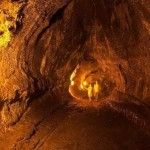Waipoao Valley
Photo/Big Island Visitors Bureau/ Kirk Lee Aeder
By Victor Block, Contributing Writer
Some vacationers soak up sun on beaches with white, black and even green sand. Nearby, skiers speed down snow-covered slopes of a dormant volcano. Other people check out a surreal moonscape of hardened pitch-black lava and hike through a lush tropical rainforest.
If this sounds like a continent-wide choice of activities, it’s because the island of Hawaii in ways resembles a miniature continent. Since it shares its name with the state, it’s often referred to as the Big Island to avoid confusion, and with good reason. It’s almost twice the size of the other Hawaiian islands combined.
Visitors find a miniature world that encompasses virtually every kind of landscape. Cactus-dotted desert lies near rain forests. Barren lava fields contrast with waterfalls plunging into verdant valleys.
Volcanoes National Park is one of the few places to come face-to-face with an active volcano. Mauna Loa has erupted 33 times in the past 175 years, most recently in 1984.
Kilauea is the world’s most active volcano. It has been erupting since 1983, and last year the lava flow invaded populated areas and prompted an evacuation by some residents. Lava flows from Kilauea add about 42 acres to Hawaii Island every year.
Those massive mountains also have another claim to fame. They measure more than 30,000 feet from their base far below the sea to the summits, making them taller than Mount Everest. Because of their height, enough snow falls on the volcanoes during winter for skiing.
The Crater Rim Drive in the park leads to several major attractions. The Jaggar Museum provides a detailed introduction to volcanoes, and the overlook outside offers a breathtaking panoramic view. The Thurston Lava Tube was formed when an underground river of molten lava ran out of its channel and the walls cooled and hardened. The aptly named Devastation Trail leads through an area that was buried beneath a thick blanket of cinders during an eruption of Kilauea in 1959.
Along with volcanoes and the usual sun-and-sand vacation activities, there are plenty of other reasons to visit Hawaii Island. For fishermen, waters off its Kona Coast are known as the best in the world for catching giant blue marlin.
Much bigger sea life drops by during whale-watching season, from December through May. While Humpbacks have top billing, it’s also possible to spot sperm and melon-headed whales.
For people who prefer to keep their feet on firm ground, hiking opportunities are outstanding. Volcanoes National Park alone offers 150 miles of trails.
For history buffs, the story of the island’s past is as intriguing as what greets visitors today. The earliest settlements were established by Polynesians who arrived after a long ocean voyage in large double-hulled canoes. Estimated dates of their arrival span hundreds of years, from the fourth to eighth centuries.
Clues to the lifestyle of the ancient Hawaiian civilization abound. They include remnants of villages, temples (heiau), agricultural mounds and other archeological remains.
Some relics, like royal fish ponds constructed to satisfy noble palates, and petroglyph lava rock carvings have been incorporated into the grounds of hotels. The images depict humans, birds and other recognizable forms as well as undecipherable lines and dots. Their precise meanings are unknown, but scientists believe that they record births, deaths and other major events, and perhaps include astronomical symbols.
One of the more intriguing sites is the Pu’uhonua o Honaunau National Historic Park, a reconstructed royal compound. Known as the “City of Refuge,” it served as a sanctuary for people who angered the gods in some way. Transgressors who were able to reach this sacred place were absolved by a priest and allowed to go free. The compound encompasses temples, sacred burial places, petroglyphs and other reminders of ancient times.
Another chapter of island history comes alive in the Waipio Valley, a six-by-one mile gash in the land rimmed by 2,000-foot high cliffs over which numerous waterfalls cascade. The meandering river they create gave the valley its name which means “curved waters.”
Also known as “Valley of the Kings,” it once was home to many rulers, and contains remains of important temples. Visitors may view the valley from a small overlook, or take a guided tour into it.
In contrast with the view at the bottom of a deep valley is the opportunity for a look at the stars as few people have seen them. Hawaii Island is home to one of the most renowned astronomical sites on the planet. Perched above the cloud cover on a dormant volcano, 13 powerful telescopes are trained on the sky.
Because of the high elevation, clear air and minimal light pollution, the stars resemble glitter scattered overhead. Guided tours include transportation, warm parkas and dinner.
An opportunity to peer at stars in a way that few people have isn’t the major reason why most people visit Hawaii Island. It’s but one in a long list of attractions that appeal to various interests well beyond the beaches, no matter what the color of the sand.
For more information about the Big Island, call 800-464-2924 or log onto gohawaii.com/hawaii-island.

Photo/Hawaii Tourism Authority/Tor Johnson












